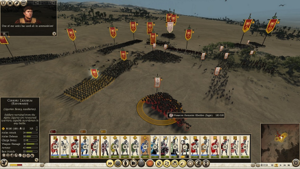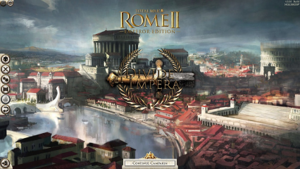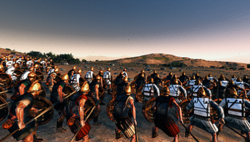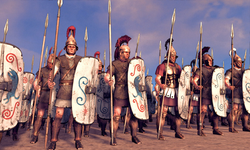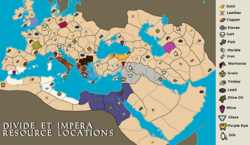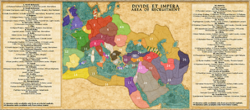Divide et Impera
Template:Mod Information Table (no map)
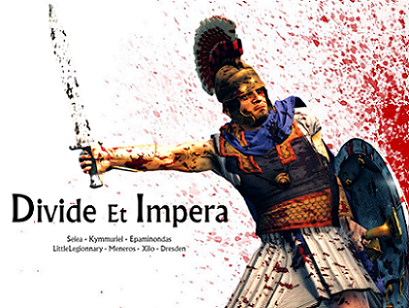
Divide et Impera (DeI) is a complete overhaul for Total War: Rome II that aims to create a more historically accurate, realistic, and fun experience for players.
Contents
History
The mod started out as a companion mod for Ars Gratia Artis (AGA) in battle mechanics and unit textures, until the the team realized that it has become more than just a companion mod. It had become a fully fledge project with the same dedication, and passion that other highly-esteemed Total war mods are known for. It released its first version on November 18th 2013.
Description
Divide et Impera(Divide and Rule) brings a lot of changes to Total War:Rome 2 by altering the battle, and campaign mechanics. With better graphics, a new reform system, faction overhaul, longer and intense campaign, realistic unit behaviour and an emphasis on strategy. It is not compatible with mods that change battle dynamics, campaign dynamics and external unit packs.
Features
DeI allows users to make any changes to the mod to suit their taste. It uses its own version of TTT, and gives a graphic overhaul to the units to potray a more accurate appearance during the era. Thanks to the new battle mechanics the AI will appropriately use unit formations when necessary to attack the player while getting rid of the "arcade" abilities. Making strategy essential for victory.
- The unit size has been increased with the ability that every infantry unit that can throw javelins will now have an option to direct where they can throw their javelins.
Factions
There are 25 playable factions with their own strength, and weaknesses as well as its own fighting style where the stances of the army (Offensive or Deffensive) affect the battle's pace. Therefore it is best to learn every faction's strength as each battle will not be the same. Each Faction have their own specialized UI in both Campaign and custome battles that fits the factions colors.
Rome
- Rome has one of the biggest rosters in DeI, making them balanced overall in units. Their main strength are their melee infantry as they have good morale, armour, and attack against other infantry. With their cavalry being better (not the best) when compared to other faction's cavalry. They are easy to micromanage making them more responsive to orders being given. They need a combination of melee infantry, skirmishers, and cavalry to be successful.
- As in the republic of Rome, it is best to use the maniple formation to combat other factions. With three lines consisting the first with the weakest infantry, the second, medium quality infantry and the third your elite troops. The skirmishers be on the front, and the cavalry on the flanks to prevent enemy infantry from flanking the main body.
- During early Campaign, Rome is a mixture between the Greek hoplites, and the Samnite maniples. This makes them spear infantry, so they are not as good as their future replacements, but are still one of the best units early in the campaign.
Greek City States
- The Greek city states include Sparta, Athens, Syracuse and other "one-city" Hellenic factions. They have a wide variety of spearmen who are slower and are primarily a defensive unit as they are able to form a phalanx that greatly increases their defensive capability.
- As with the Romans it is best to have a balanced and organized method of warfare. Although there is emphasis on the battle terrain that you choose as slopes and irregularities weaken the army. So it is preferably to fight on plains and flat lands. But are not completely dependent to the terrain.
- It's preferably to use javelins early in the campaign, and once given the chance recruit/invest in archers. This is because the hoplites are not so mobile as the Romans.
- A method of using them is to have a single front of hoplite troops with a couple of units positioned in the rear. However this method makes the javelinmen have a hard time retreating behind the lines, and suffer a few casualties. This is why it's preferably to use archers as they can stay behind lines, while remaining at a safe distance.
Macedon, Successor Kingdoms
- Similar to the Greek states they suffer from a lop-sided roster, which is compensated with a wide variety of pikemen and cavalry units. Pikemen are slower than hoplites and cannot withstand a fight against melee infatry compared to the hoplites. They are considered to be more dependent on terrain and can easily be caught off formation with tactful maneuvers. They are decent at holding long enough for their cavalry to take the initiative.
- All pike-men are to be arranged in a straight single line formation leaving no gaps between units. It's best to leave them off phalanx mode until the enemy charges as they suffer less damage from missile fire. While hoplites are placed at each flank.
- Successor Kingdoms fight similar to the Greek states but lay more emphasis on "Hammer and Anvil" techniques. In which the pikemen pin down the enemy line therefor, acting like the anvil, and the high quality shock cavalry, charge the enemy rear to create maximum damage behaving like the hammer. It is best to maintain the formation of the collective force at all times when using a pike infantry army. This formation should not be broken.
Barbarian Factions
- Quite balanced like the Romans, but are best used in ambush tactics and fighting in numbers. They have a good variety of spear and me-lee infantry and good cavalry. But lack a good defense and therefore, a stretched out battle/skirmish can work against them.
- They need to use their superior charge bonus and surprise tactics to create maximum demoralization to the enemy. Even their cavalry has one of the highest charge bonuses in game. Making them the best at ambush.
- The barbarians are not at their best in open fields as they are better fit at night in a forest where they excel at stealth. Demoralizing is the best tactic for a barbarian faction. Fighting in forests is used for two purposes; incoming enemy projectiles, and bait the enemy for an ambush. If unable to fight in a dense forest, keep your army near a batch of trees.
Nomadic Factions
- Nomads have a very lop-sided roster. Mostly cavalry melee, schock and missile with very few infantry units, and even those infantry units can't compete against other infantry units from other factions. They are best used in open space, but are the worst at defending a city, and taking a city. But even then they are still a force to be reckoned with.
Campaign
- Seasons are implemented with a four turn per year. It affects the general's army by inflicting a harsh movement penalty. Each province has a random chance of getting good, bad or normal seasons whith each season's effect varying depending on the location the army is on the map.
- Resources such as wine, timber and salt and many more are acquired through either trade or conquest depending on the land they are in. This allows the construction of resource buildings.
- Armies use 1 food in the region they are in unless they are garrisoned. That allows replenishment of units, ammunition while giving various bonuses on culture, but gives a negative effect on public order. armies have a limit on the number of same units there can be..
- Dignitaries can now act as governors, and be deployed in provinces to increase their skills and help improve public order, cultural conversion and many other aspects.
- Reform system affects the type of units that are available for recruitment and change depending on the Imperium level, and the number of turns. Each faction has a certain target in order to trigger a unit/culture reform (Polybia --> Marian --> Imperial), once reached the old units will no longer be available for recruitment. This is INDEPENDENT from the tech tree.
- Recruitment of certain units are only available in certain regions and require a definite amount of your faction's culture. The exception are regions that are historically that culture such as Greek troops.
- Mercenary units can be recruited by any faction. Although Carthage and Egypt have special privileges for factional mercenaries that they can recruit anywhere.
The Team
- Meneros (Lead; Texture, Model and Unit)
- Ritter-Floh (Texure, Model and Unit; Animator)
- Don_Diego (Texture, Model and Unit)
- Ahiga (Texture, Model and Unit)
- Dresden (Lead; Compilation and Tech/Debug; Campaign Systems and Gameplay Design)
- Litharion (Compilation and Tech/Debug; Lead in Scripting; Campaign Systems and Gameplay Design)
- KAM 2150 (Lead; Battle Systems)
- Gunny (Battle Systems)
- m_1512 (Campaign Systems and Gameplay Design; UI and Art)
- Moonhoplite (Animator)
- Rafkos (Translator)
- Idreaus (UI and Art)
- Leving (UI and Art)
- Summary (UI and Art)
- Epic28 (UI and Art)
Visual Material
Unit Previews
Campaign Map
